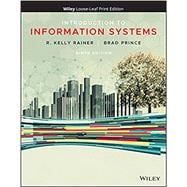Introduction to Information Systems, 9th Edition teaches undergraduate business majors how to use information technology to master their current or future jobs. Students develop a working understanding of information systems and information technology and learn how to apply concepts to successfully facilitate business processes. This course demonstrates that IT is the backbone of any business, whether a student is majoring in accounting, finance, marketing, human resources, production/operations management, or MIS.








